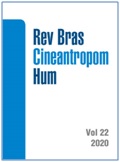Espessura muscular e desempenho funcional em pacientes com doença de Parkinson
DOI:
https://doi.org/10.1590/1980-0037.2020v22e60774Resumo
Os objetivos do presente estudo foram: a) testar se existe diferença entre os valores de espessura muscular mensurados por ultrassonografia em três diferentes pontos, nos músculos flexores de cotovelo e extensores do joelho em pacientes com doença de Parkinson (DP); b) Testar se existe correlação entre a espessura muscular e desempenho funcional em pacientes com DP. A medida de espessura muscular foi avaliada por ultrassonografia em três pontos anatômicos nos flexores de cotovelo (proximal – FC1, médio, FC2, e distal – FC3) e extensores de joelho (proximal – EJ1, medial - EJ2, e distal – EJ3), além da avaliação do desempenho funcional (teste de sentar e levantar, e flexão de cotovelo) de 31 pacientes (64.6 ± 10.6 anos de idade) com DP. Os resultados sugerem que a espessura muscular do ponto FC3 foi significativamente (p>0.05) menor que os valores do ponto FC2 e FC1. A espessura muscular dos extensores do joelho foi estatisticamente diferente nos pontos anatômicos dos músculos reto da coxa e vasto intermédio (EJ1>EJ2>EJ3). Não houve correlação entre a espessura muscular e o desempenho funcional dos membros inferiores (r= 0.17; p= 0.35) e superiores (r= -0.17; p= 0.34) de pacientes com DP. Os resultados do nosso estudo indicam que o ponto anatômico de mensuração exerce influência significativa na espessura muscular dos flexores do cotovelo e extensores do joelho de pacientes com DP. Desta forma, a determinação criteriosa dos locais de avaliação da espessura muscular é uma variável fundamental, quando o objetivo é quantificar a espessura muscular em pacientes com DP.Referências
GBD 2016 Parkinson’s Disease Collaborators. Global, regional, and national burden of Parkinson’s disease, 1990–2016: a systematic analysis for the Global Burden of Disease Study 2016. Lancet Neurol 2018;17(11):939-953.
Poewe W, Seppi K, Tanner CM, Halliday GM, Brundin P, Volkmann J, et al. Parkinson disease. Nat Rev Dis Primers 2017;23(3):17013.
Tan AH, Hew YC, Lim SY, Ramli NM, Kamaruzzaman SB, Tan MP, et al. Altered body composition, sarcopenia, frailty, and their clinico-biological correlates, in Parkinson's disease. Parkinsonism Relat Disord 2018;56:58-64.
Dirks ML, Wall BT, van de Valk B, Holloway TM, Holloway GP, Chabowski A, et al. One week of bed rest leads to substantial muscle atrophy and induces whole-body insulin resistance in the absence of skeletal muscle lipid accumulation. Diabetes 2016;65(10): 2862-75.
Peake J, Della Gatta P, Cameron-Smith D. Aging and its effects on inflammation in skeletal muscle at rest and following exercise-induced muscle injury. Am J Physiol Regul Integr Comp Physiol 2010;298(6):R1485-95.
Selva Raj I, Bird SR, Shield AJ. Ultrasound Measurements of Skeletal Muscle Architecture Are Associated with Strength and Functional Capacity in Older Adults. Ultrasound Med Biol 2017;43(3):586-594.
Radaelli R, Neto ENW, Marques MFB, Pinto RS. Espessura e qualidade musculares medidas a partir de ultrassonografia: influência de diferentes locais de mensuração. Rev Bras Cineantropom Desempenho Hum 2011;13(2):87-93.
Gelb DJ, Oliver E, Gilman S. Diagnostic criteria for Parkinson disease. Arch Neurol 1999;56(1):33–39.
Folstein MF, Folstein SE, McHugh PR. "Mini-mental state". A practical method for grading the cognitive state of patients for the clinician. J Psychiatr Res 1975;12(3):189-198.
Marin RV, Pedrosa MA, Moreira-Pfrimer LD, Matsudo SM, Lazaretti-Castro M. Association between lean mass and hand grip strength with bone mineral density in physically active postmenopausal women. J Clin Densitom 2010;13(1):96-101.
Rikli RE, Jones CJ. Development and validation of a functional fitness test for community-residing older adults. J Aging Phys Activity 1999;7(2):129-61
Miyatani M, Kanehisa M, Ito M, Kawakami Y, Fukunaga T. The accuracy of volume estimates using ultrasound muscle thickness measurements in different muscle groups. Eur J Appl Physiol 2004;91(2-3):264–272.
Abe T, Dehoyos D, Pollock M, Garzarella L. Time course for strength and muscle thickness changes follow upper and lower body resistance training in men and women. Eur J Appl Physiol 2000;81(3):174-80.
Thiebaud RS, Yasuda T, Loenneke JP, Abe T. Effects of low-intensity concentric and eccentric exercise combined with blood flow restriction on indices of exercise-induced muscle damage. Interv Med Appl Sci 2013;5(2):53-59.
Matta TT, Nascimento FX, Trajano GS, Simão R, Willardson JM, Oliveira LF. Selective hypertrophy of the quadriceps musculature after 14 weeks of isokinetic and conventional resistance training. Clin Physiol Funct Imaging 2017;37(2):137-142.
Meghan EV, Melissa D, Michael EM, Cralen CD, Anthony PM, Katherine RS. Characterizing upper limb muscle volume and strength in older adults: A comparison with young adults. J Biomech 2012;45(2):334–341.
Garcia P. Relation of functional capacity, strength and muscle mass in elderly women with osteopenia and osteoporosis. Fisioter Pesqui 2015;22(2):126–32.
Morse CI, Thom JM, Birch KM, NariciMV. Changesintriceps surae muscle architecture with sarcopenia. Acta Physiol Scand 2005;183:291–298.
Narici MV, Binzoni T, Hiltbrand E, Fasel J, Terrier F, Cerretelli P. In vivo human gastrocnemius architecture with changing joint angle at rest and during graded isometric contraction. J Physiol 1996;496(Pt 1): 287–297.
Moroney R, Heida C, Geelen J. Increased bradykinesia in Parkinson's disease with increased movement complexity: elbow flexion-extension movements. J Comput Neurosci 2008;25(3):501-19.
Yohei T, Megumi O, Ryota A, Hiroaki K, Yasuo K, Tetsuo F. Sit-to-stand test to evaluate knee extensor muscle size and strength in the elderly: a novel approach. J Physiol Anthropol 2009;28(3):123-8.
Akira S, Ryoichi E, Takayuki I, Sumiaki M, Shun O, Mitsuru H, et al. Anatomical cross-sectional area of the quadriceps femoris and sit-to-stand test score in middle-aged and elderly population: development of a predictive equation. J Physiol Anthropol 2017; 36:3.
Melissa D, Meghan EV, Joel DE, Greg S, Michael EM, Anthony PM, Katherine RS. Upper extremity muscle volumes and functional strength after resistance training in older adults. J Aging Phys Act 2013;21(2):186–207.
Downloads
Publicado
Edição
Seção
Licença

Direitos Autorais para artigos publicados nesta revista são do autor, com direitos de primeira publicação para a revista. Em virtude da aparecerem nesta revista de acesso público, os artigos são de uso gratuito, com atribuições próprias, em aplicações educacionais e não-comerciais, desde que seja dada a atribuição. Esta obra foi licenciada com uma Licença Creative Commons Atribuição 4.0 Internacional - CC BY


